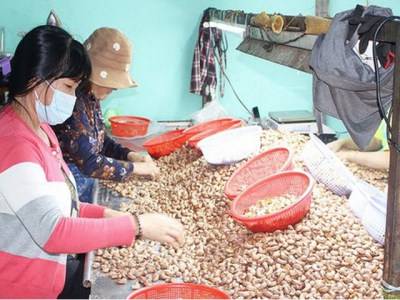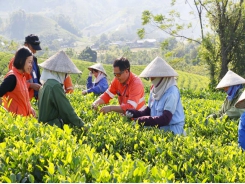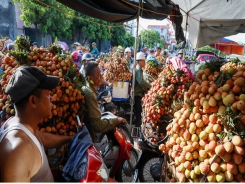Farmers in Southeast provinces have bad crop of cashew

Cashew farmers in the Southeast provinces are rushing to enter the harvest season. Due to unusual weather, many cashew plantations have suffered heavy losses, but well-cared-for cashew ones still give high yields.
Preliminary processing of cashew for export at Hoang Linh Linh Company Limited in Cam My District in Dong Nai Province. (Photo: SGGP)
Cashew productivity mainly depends on the weather
Binh Phuoc Province is considered as the cashew capital of the country, with about 170,000 hectares and an output of 243,000 tons per year, mainly concentrated in Phu Rieng, Bu Gia Map, Bu Dang, and Dong Phu districts. This place creates jobs for about 50,000 workers in rural areas.
Mr. Dieu Thanh, a farmer in Dak O Commune in Bu Gia Map District, has two hectares of over-20-year-old cashew trees that are developing well and not damaged by cashew stem borer as in previous years. He spent VND10 million for fertilizing and spraying nourishing agents for cashew flowers. His cashew trees were blooming more flowers than the previous year. Unfortunately, after the Lunar New Year, there was a prolonged period of hoar frost, causing cashew flowers to dry, and young cashew fruits to fall a lot. During this time in the previous year, his family collected 2 tons of fresh cashew, but up to now, only about 100 kilograms of fresh cashew have been collected. Many households in the commune also suffered from lean harvest in this crop.
On the contrary, Mr. Nguyen Van Long, a farmer in Tien Hung Commune in Dong Xoai City, has three hectares of cashew trees that are giving high yield. Currently, Mr. Long's family is entering the second phase of the harvest season, with a yield of 2 tons per hectare. Cashew prices are stable at VND24,000-VND27,000 per kilogram of fresh cashew, after deducting expenses, his family earns more than VND1 billion. Mr. Long said that cashew trees give a good harvest or not, it depends a lot on the weather, fertilization, and care. Right from the beginning of the year, his family pruned branches, removed old cashew trees with low productivity, and spend nearly VND20 million to fertilize and spray plant protection drugs, so the garden is clean and free from pests and diseases.
A survey in many cashew plantations in localities with large cashew areas such as Bu Dang, Dong Phu, and Bu Gia Map districts shows that if the cashew plantations are taken care of well, the trees have fewer pests and diseases and give an average yield of 2 tons per hectare. Many cashew plantations are close to each other, but there is a quite large difference in productivity because the care and cultivation capacity of each household is different.
Because cashew trees give fruits late this year, the 250-hectare organic cashew plantation that meets the European standards of Mr. Dung Quy Dong in Tan Hung Commune of Dong Phu District has just been harvested for half a month this month. According to Mr. Dong, organic cashew cultivation is not affected by weather and pests, so the yield next year is higher than the previous year.
Mr. Dong shared that last year, in the first harvest with nearly 100 hectares, his family collected more than 200 tons of cashew. It is expected that his cashew plantation would produce about 500 tons of cashew this year. With the current price, he would earn more than VND10 billion. However, because of the large harvest area, he was worried about a labor shortage.
Currently, he needs 150-200 workers every day, but he has just been able to hire 100 regular workers at the price of VND250,000 per person per day, higher than the previous year.
Taking care of the cash crop
The Department of Agriculture and Rural Development of Binh Phuoc Province admitted that this year due to the high-temperature difference between day and night, it had negative impacts on the flowering and fruiting of cashew trees, but well-cared-for cashew plantations have fewer harmful pests and diseases and cashew yield is still high. The Department recommended that farmers need to take care of their cashew plantations regularly and should not abuse pesticides. Especially, they should use the right drugs and dosage, choose safe plant protection drugs for the trees, ensure health for people, and reduce care costs.
Mr. Tran Quoc Tuan, Director of the Statistics Office of Dong Nai Province, said that the whole province has about 36,000 hectares of cashew trees, down nearly 14,000 hectares compared to 2010. Farmers continue to chop down cashew trees to switch to other crops with higher economic efficiency, due to low cashew prices and its dependence on the weather.
According to the agricultural sector of Dong Nai Province, cashew can be grown in sloping areas, especially in ethnic minority areas and remote areas. Cashew is still considered as a crop for hunger eradication and poverty alleviation and key crop. The industry will carry out solutions to remove difficulties for farmers, such as finding and expanding the consumption markets, supporting and encouraging people to apply scientific and technical advances in production to improve productivity, quality, and promote deep processing.
Binh Phuoc Province is facing the situation of selling young cashew in the ethnic minority areas. If there were only 482 households selling young cashew, with a total area of 683.75 hectares for VND28.8 billion in 2017, there were 663 households last year, with a total area of 1,161.13 hectares for more than VND37.5 billion, concentrated in Bu Dang and Bu Gia Map districts. To stop this situation, the provincial People's Committee has instructed authorities to focus on propaganda about the forms and tricks of the subjects who buy young cashew to raise awareness for farmers to prevent frauds that lead to debts, foreclosure, and loss of cultivation land.
Có thể bạn quan tâm
Phần mềm

Phối trộn thức ăn chăn nuôi

Pha dung dịch thủy canh

Định mức cho tôm ăn

Phối trộn phân bón NPK

Xác định tỷ lệ tôm sống

Chuyển đổi đơn vị phân bón

Xác định công suất sục khí

Chuyển đổi đơn vị tôm

Tính diện tích nhà kính

Tính thể tích ao hồ



 Ben Luc: 1,200 hectares of high-tech lemons planted
Ben Luc: 1,200 hectares of high-tech lemons planted  Vietnamese rice export price reaches record level
Vietnamese rice export price reaches record level